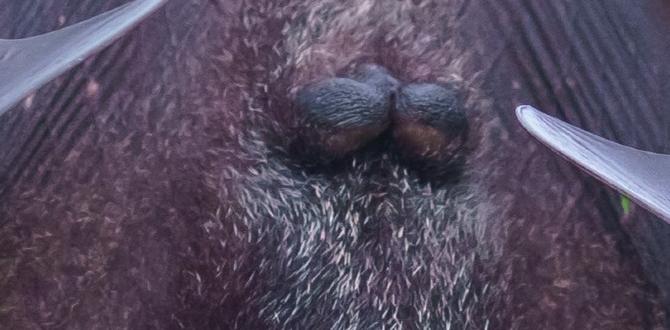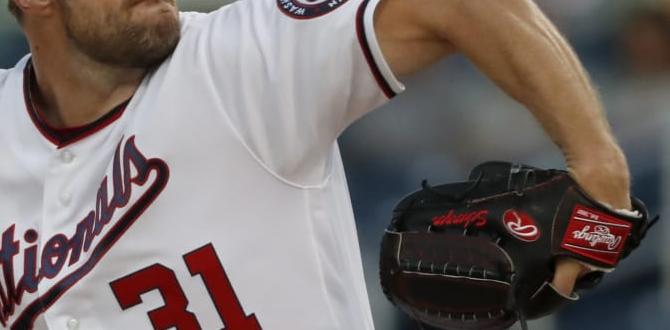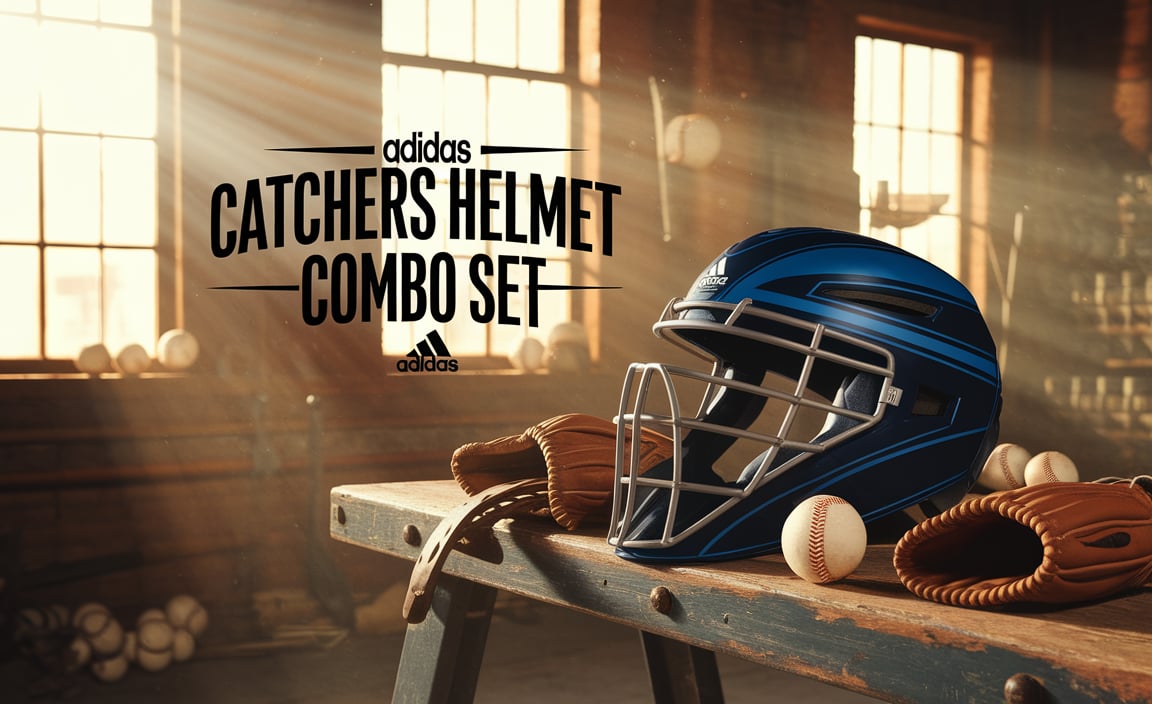Quick Summary: Force3 shin guards offer superior protection and comfort for catchers. This guide compares key Force3 models, highlighting their features, benefits, and ideal player types to help you choose the best pair for your game.
Force3 Catchers Shin Guards: Essential Comparison for Every Player
Hey everyone, John P. Miller here, your go-to guy for all things baseball at FriskMode! Hitting the dirt, blocking pitches, and taking foul tips – being a catcher is tough work. One of the most crucial pieces of gear that keeps you in the game and safe is your shin guards. But with so many options out there, especially when you look at a brand like Force3, it can be a bit confusing to pick the right ones. You want protection, sure, but also comfort and mobility. If you’ve ever felt like your current shin guards are holding you back or just not cutting it, you’re in the right place. We’re going to break down Force3 shin guards, making it super easy to find your perfect fit.
Why Shin Guards Matter for Catchers
Let’s get down to brass tacks: your shins are prime targets. From errant pitches bouncing in the dirt to foul balls rocketed right back at you, your lower legs take a lot of impact. Good shin guards are your first line of defense, preventing bruises, cuts, and more serious injuries. But they’re not just about stopping pain; they’re about allowing you to perform at your best. Shin guards that are too bulky or don’t fit right can restrict your movement, making it harder to get out of your stance, field a bunt, or throw a runner out. The goal is to find a balance: maximum protection with maximum agility.
Introducing Force3 Shin Guards: Innovation in Catcher Protection
Force3 is a brand that’s really made a name for itself by focusing on catcher-specific protection. They understand the unique demands placed on catchers and have engineered gear to meet those needs. Their philosophy often centers around advanced impact absorption technology and ergonomic designs. This means they’re not just slapping some padding onto a plastic shell; they’re thinking about how the gear moves with the player and how it disperses force effectively. For beginners, this translates to feeling more secure behind the plate, allowing you to focus on developing your skills rather than worrying about getting hurt. For seasoned players, it means gear that can stand up to the rigors of intense competition.
Key Force3 Shin Guard Models: A Closer Look
Force3 offers a few standout models, each designed with specific player needs in mind. We’ll compare two of their most popular lines to help you see the differences:
1. Force3 Ultimate Catchers Shin Guards
These are often considered the flagship model from Force3. They are built for maximum protection and durability, making them a top choice for serious catchers at higher levels of the game, but also a fantastic, confidence-boosting option for determined beginners ready for robust gear.
Features and Benefits:
- Advanced Impact Protection: Force3’s proprietary “Shocksplosion” technology is designed to absorb and disperse impact energy like nothing else. This is particularly important for blocking pitches in the dirt, as it can significantly reduce the sting and potential for injury.
- Full Leg Coverage: These shin guards extend high up to offer protection for the kneecap and the entire shin area, minimizing the risk of foul tips to the knee.
- Ergonomic Design: Despite their protective capabilities, they are designed for a good range of motion. The articulation at the knee allows for natural bending and movement.
- Durable Construction: Built with high-quality materials, these guards are made to withstand the constant wear and tear of a baseball season (or several!).
- Comfortable Liner: Padding inside is designed for comfort during long games and practices, helping to wick away moisture and prevent chafing.
- Adjustable Straps: Secure and customizable fit ensures the guards stay in place no matter how much you move.
Who are they for?
Serious competitive catchers, players who prioritize the absolute best protection, and those who spend a lot of time behind the plate. They are an investment in your long-term ability to catch.
2. Force3 Pro-SR Catchers Shin Guards
The Pro-SR line offers a slightly more streamlined approach, aiming to provide excellent protection with an emphasis on lighter weight and enhanced mobility. This can be an attractive option for many players, including those who might find the Ultimate model a bit more substantial than needed.
Features and Benefits:
- Exceptional Impact Absorption: While possibly a variation on the “Shocksplosion” concept or using similar principles, the Pro-SR guards still deliver robust protection against foul balls and pitches.
- Lightweight Design: These guards are typically lighter than the Ultimate model, which can lead to less fatigue over the course of a game and quicker movements.
- Streamlined Fit: They often feature a sleeker profile that can feel less bulky, allowing for easier movement and a closer feel to the leg.
- Great Knee Protection: The jointed knee cap provides excellent coverage and flexibility, crucial for squats and quick transitions.
- Breathability: Often designed with ventilation in mind, helping to keep catchers cooler.
- Secure Strapping System: Reliable straps ensure the guards stay put and provide a snug fit.
Who are they for?
Catchers who want top-tier protection but also value speed and agility. This is a great choice for players at high school, college, or even professional levels, as well as any catcher who wants a lighter feel without sacrificing crucial safety.
Comparing Key Elements: A Deeper Dive
To really understand the differences, let’s break down some key aspects that matter to every catcher:
Protection Technology
Both the Ultimate and Pro-SR lines from Force3 utilize advanced materials to absorb and dissipate impact. The core differentiator might be the degree of protection and the thickness of materials used, with the Ultimate line generally offering the absolute maximum. Force3’s commitment to this technology is a major selling point, as it directly impacts safety and confidence. For a deeper understanding of impact absorption in sports equipment, you can explore research from institutions like the National Highway Traffic Safety Administration (NHTSA), which, while focused on vehicles, details principles of crumple zones and energy dispersion that are analogous to protecting the human body.
Weight and Mobility
This is where the Pro-SR often shines for players seeking agility. Lighter gear means less effort to move quickly, get out of your stance, or chase down a passed ball. The Ultimate guards, while still designed for movement, will inherently have a bit more bulk due to the extra padding and materials contributing to their superior protection. If you’re a catcher who relies on quickness and agility, the Pro-SR might feel like a better match. If you’re a bigger catcher or one who prefers maximum cushioning and doesn’t mind a bit more weight, the Ultimate could be your pick.
Coverage and Articulation
Both models aim for comprehensive coverage, including the shin, ankle, and knee. The articulation, or the way the guard bends, is vital. A well-articulated shin guard allows you to maintain a natural defensive posture without feeling restricted. Force3 generally does an excellent job here, ensuring the knee cap moves with your leg. The Ultimate model might offer slightly more overlapping coverage for added safety, while the Pro-SR focuses on providing that coverage in a less bulky package.
Durability and Materials
Force3 is known for using robust materials designed for the rigors of baseball. You can expect high-grade plastics, strong straps, and resilient padding in any of their catcher-specific gear. The Ultimate line likely uses denser, more advanced impact-absorbing foams and thicker outer shells, contributing to its longer lifespan under extreme use. The Pro-SR still uses durable materials but may opt for lighter composites that offer excellent performance without the same level of density.
Comfort and Fit
Comfort goes hand-in-hand with performance. Well-padded shin guards prevent chafing and reduce the shock that travels up your leg. Both Force3 lines incorporate comfortable inner linings. The fit is crucial; shin guards that are too loose can shift and offer poor protection, while those too tight can impede circulation and cause discomfort. Adjustable straps on both models allow for a customized, secure fit, but the overall shape and contouring might differ, so trying them on if possible is always a good idea.
Force3 Shin Guards vs. Other Brands: What Sets Them Apart?
Many brands offer catcher shin guards, but Force3 has carved out a niche with its specialized technology. While other brands might focus on a blend of protection and value, or cater to a broader range of sports, Force3’s singular focus on the catcher position shines through. Their “Shocksplosion” technology, for example, is a patented system aimed at unique impact dispersal that differentiates them. Other brands might rely on traditional EVA foam or simpler padding structures. Force3’s commitment to innovation means you’re often getting cutting-edge protection specifically engineered for the extreme demands of catching.
Choosing the Right Size for Your Force3 Shin Guards
Getting the right size is critical for both protection and comfort. Shin guards are typically sized based on leg length, measured from the center of the kneecap to the bottom of your shin (where the tongue of your shoe would end).
Here’s a general guideline:
- Youth Small/Medium: Typically for players up to 5’0”
- Youth Large / Intermediate: Around 5’0” – 5’6”
- Adult Small: Around 5’6” – 5’10”
- Adult Medium: Around 5’10” – 6’2”
- Adult Large: 6’2” and above
Always check the specific sizing chart for the Force3 model you are interested in, as measurements can vary slightly. Crucially, when trying them on, ensure they cover your knee thoroughly and extend down to your shoe without leaving a gap. The straps should allow for a snug fit without being restrictive.
Proper Care for Your Force3 Shin Guards
To get the most out of your investment and ensure they function correctly for a long time, proper care is essential:
- Cleaning: After each use, wipe down the exterior with a damp cloth to remove dirt and sweat. For the interior padding, use a mild soap and water solution and a soft brush or cloth. Ensure all cleaning agents are washed off thoroughly.
- Drying: Always air dry your shin guards completely before storing them. Do not leave them in a tightly closed equipment bag where moisture can lead to odor or material degradation. Hanging them in a well-ventilated area is ideal.
- Storage: Store your shin guards in a cool, dry place away from direct sunlight, which can degrade plastic and padding over time.
- Inspection: Regularly check the straps, buckles, and padding for any signs of wear and tear. Replace any damaged parts promptly to maintain optimal protection.
Following these simple steps will help maintain the integrity of the protective technology and comfort features of your Force3 shin guards.
Force3 Catchers Shin Guards Comparison Table
To give you a quick snapshot, here’s a table comparing the general characteristics of the two Force3 models we’ve discussed:
| Feature | Force3 Ultimate Catchers Shin Guards | Force3 Pro-SR Catchers Shin Guards |
|---|---|---|
| Primary Focus | Maximum Protection & Advanced Impact Absorption | Excellent Protection with Enhanced Mobility & Lighter Weight |
| Impact Technology | Proprietary “Shocksplosion” (highest level) | Advanced Impact Dispersion (highly effective) |
| Weight | Heavier | Lighter |
| Bulkiness | More Substantial | Streamlined |
| Ideal Player | Serious competitors, those prioritizing ultimate safety | Agile catchers, players valuing speed, all levels seeking balance |
| Price Point | Premium | High-end Premium |
| Coverage | Comprehensive, full leg and knee coverage | Excellent coverage with focus on flexibility |
Frequently Asked Questions About Force3 Shin Guards
1. Are Force3 shin guards worth the cost?
For many serious catchers, yes. They offer a level of specialized protection and innovative technology that can be crucial for injury prevention and sustained performance. While they are an investment, the durability and advanced safety features often justify the price for dedicated players.
2. How often should I replace my Force3 shin guards?
With proper care, Force3 shin guards are built to last. However, you should inspect them regularly for cracks, significant wear on padding, or damaged straps. If you notice any compromise in their protective integrity, it’s time for a replacement, typically after several seasons of heavy use, depending on how often you play and practice.
3. Can I use a single shin guard if I only need one?
Force3 shin guards are designed and sold as a pair. It is highly recommended to wear both to ensure consistent protection and balance. Using only one could lead to uneven wear on your body and a false sense of security.
4. How do Force3 shin guards compare to traditional catcher’s leg guards?
Traditional leg guards are often a one-piece unit that covers the entire lower leg and foot. Force3 shin guards, on the other hand, are typically a two-piece, more anatomically fitted design that emphasizes flexibility and superior impact absorption via proprietary materials, rather than just stiff plastic shells.
5. Are Force3 shin guards comfortable for long periods?
Yes, comfort is a key design element for Force3. They use advanced padding and ergonomic shaping to ensure a comfortable fit, even during extended games or practices. The breathable liners also help manage moisture and prevent discomfort.
Conclusion: Making the Right Choice for Your Game
Choosing the right catcher’s shin guards is a big decision, and when you’re looking at a brand like Force3, you’re investing in some of the best protection available. Whether you lean towards the absolute maximum coverage of the Ultimate shin guards or the lightweight agility of the Pro-SR model, you’re getting top-tier quality designed specifically for the demands of the catcher position. Remember to consider your own playing style, your level of experience, and what feels most comfortable and protective for you. By understanding the features, comparing the key differences, and ensuring you get the right fit, you’ll be well on your way to feeling more confident and safe behind home plate. Happy catching!



